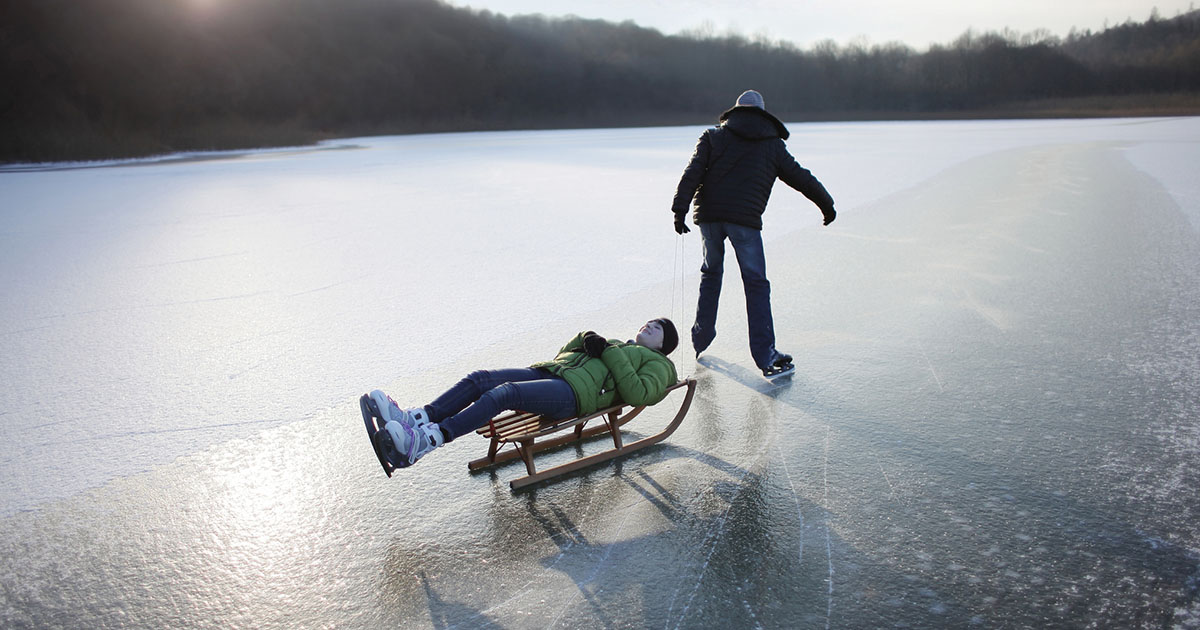How to Stay Safe on Ice this Winter

The frozen surfaces of lakes, rivers, and ponds can be deceiving, and it’s essential to take the necessary safety precautions.
If you’re thinking of sledding, walking, or cross-country skiing across frozen bodies of water you need to make sure to check the thickness of the ice, stick to designated areas, bring the right gear, and know what to do in case of an emergency.
Check ice thickness
When it comes to ice safety, one of the most important things to do is check the thickness of the ice. If the ice is not thick enough, it can crack or break, putting you at risk of falling into the water.
Safe ice thickness
Before you travel across a frozen lake, pond, or river, make sure the ice is thick enough to support your weight. Ice should be:
- 25 cm thick for snowmobiling
- 20 cm thick for groups skating, walking, cross-country skiing, or sledding
- 15 cm thick for walking or skating alone
Measuring ice thickness
You can compare checking ice thickness to checking the oil in your car. Use an ice auger, ice chisel, or cordless drill to make a hole in the ice. Hook the edge of a tape measure on the edge to see how thick it is.
Types of ice
When measuring ice thickness, you also need to consider what type of ice it is.
The strongest type of ice is clear blue. White, opaque ice is half as strong and is formed by wet snow freezing on the ice. Opaque ice needs to be twice as thick as clear blue ice for safe travel on it. Ice on rivers is about 15% weaker than on non-running bodies of water.
Grey ice indicates that water is present and is unsafe to travel on.
Stay in designated areas and be cautious
When walking, sledding, or cross-country skiing on a frozen lake, river, or pond, it is best to stay on designated trails that have been cleared and marked as safe.
Avoid areas where there may be thin ice or open water. Bring a friend if possible and make sure you return before the sun sets. Be extra careful on snow-covered ice because the snow can hide cracks and open water.
Bring the right gear
Bring ice safety supplies with you if you will be travelling across ice.
- Bring crampons for walking on ice.
- Ice picks can be used to pull yourself out of the water if you fall through the ice.
- Have a portable flotation device in case someone falls in the water.
- Wear proper clothing to protect yourself from the cold.
Have an emergency plan
It is important to have an emergency plan for an accident on the ice and to know how to safely get out of the water if you fall through the ice. Have a cell phone with you in case you need to call for help.
If you fall through the ice
If the ice breaks and you fall in the water, you have about 2-5 minutes to get out. Kick your legs and try to climb horizontally back onto the ice. If you have ice picks, use them to pull yourself up. Roll towards thicker ice. Get to warmth and shelter immediately to prevent hypothermia.
If someone else has fallen through the ice
If someone has fallen through the ice, throw them a rope, tree branch, or another object that can be used to pull them out. Call 911 if no such object is available. Work quickly to prevent hypothermia once they are out of the water. If your pet has fallen through, call 911. The ice will not support you if it did not support your pet.



